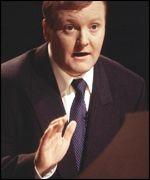


From
CNN.com: [oktober 11, '05] "
They walk up to an ATM and press their thumbs on the screen. Out spits the cash. - New York? No. Chicago? No. The mountains and jungles of Colombia"
The use of Biometrics (human identification through physical or behavioral characteristics) is on the rise. Yet in some markets, such as the US, progress has been slow: the issue of privacy is one of the main reasons. South America has become a budding market for fingerprint technology, because people are already used to using fingerprints for identification.
Some of the latest technologies are very interesting, for example
body odor or
brainwave recognition, or analyzing your
typing rhythm!
The use of biometrics would have been much more widespread, if it were not for some problems: none of the technologies are completely reliable, they tend to be quite costly, and some are inefficient. There are also many people who feel uneasy with the most commonly used biometrics technologies, such as fingerprint and eye recognition. Sticking your eye in front of your camera, putting your finger or hand on a surface touched by thousands of others, and having personal things about ourselves recorded - not everyone feels comfortable with that. For all these reasons, a lot of different biometrics technologies are still being developed and tried out.
Aside from fingerprint identification, other types of Biometrics are:
- Facial recognition - based on facial features or pattern of flood vessels underneath the skin.
- Hand geometry - based on the shape of the hand or the pattern of the veins
- Eye recognition - based on either iris (which surrounds the pupil) or retina (pattern of blood vessels at the back of the eye).
- Voice verification
- Signature recognition
- Keystroke dynamics - the rhythm with which one types is distinctive!
- Nail recognition
- DNA
Biometrics technologies still under development:
- Mouse dynamics
- Gait recognition - the way you walk
- Scent and body odor
- Automated Dental Identification System
- Ear lobe measurements
- Thermal emission
- Brainwave reading
- More
The fact that the fingerprint lines or dermatoglyphics can reveal information about ourselves, such as diseases, is dispelled as a myth by biometrics developers and researchers. True, the biometrics technologies probably do not record the relevant information from our hands. However, the idea that these lines reveal information about ourselves is of course not a myth at all: those who say so just have not been keeping up with the latest research. Or they are purposefully ignoring it in order to market their biometrics technologies.



 "Devender Harne, 10, was born with 25 fingers and toes -- six fingers on each hand, six toes on one foot and seven on the other."
"Devender Harne, 10, was born with 25 fingers and toes -- six fingers on each hand, six toes on one foot and seven on the other." 



